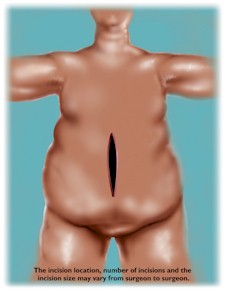Gastric Band
INTRODUCTION
Normally the stomach has a large capacity so one can have a large meal before a feeling of satiety is reached. After passage through the stomach food will be digested and absorbed in the small bowel. Undigested food and fibers pass the bowel and will be excreted.
There are several surgical options in the treatment of obesity which help you to loose weight. Some procedures limit the amount of food that can enter the stomach (=restrictive) while other procedures prevent complete absorption in the small bowel (=malabsorptive).
A Gastric Band acts by limiting the amount one can eat during a meal without feeling hungry and with a longer lasting feeling of satiety.
PREPARATION TO THE PROCEDURE
Depending on your age one of the following tests might be necessary:
- Laboratory / Blood tests
- Electrocardiogram with or without cardiac check-up
- Chest X-ray with or without pulmonary check-up
In case of regular medication usage one has to inform their surgeon, especially in case of blood thinners (aspirin, anti coagulants, anti-inflammatory drugs, http://www.ncpainmanagement.com/BloodThinners.htm ) as these need to be stopped before surgery.
On the day of surgery you will have to remain sober. If necessary some medication can be taken with a little water.
PROCEDURE
During a laparoscopic procedure a gastric band is placed around the upper part of the stomach. A small pouch is created which allows food to pass at a slower pace. After passing through the rest of the stomach a normal digestion takes place.
The gastric band will , after being fixated, be attached to a port which will be placed in an easily reachable place under the skin. This port can be used to inflate the band in order to tighten or loosen the band over time to change the size of the passage.

SURGERY THROUGH LAPAROSCOPIE
Weight loss surgery is done by laparoscopy also called minimally invasive surgery or keyhole surgery . It is a modern surgical technique in which operations in the abdomen are performed through small incisions (usually 2-3cm) as compared to larger incisions needed in traditional surgical procedures.
The abdomen is inflated creating sort of ‘air bubble’ as working space. Through 4 or 5 small incisions a camera and small instruments are placed inside your abdomen. The rest of the procedure takes place inside the abdomen.
After the surgery when a patient awakes he or she can experience pain in the shoulders due to the insufflation. Normally this pain disappears within a couple of days.
COMPLICATIONS
1. During surgery or while hospitalized.
As with any surgery, there can be complications. These can occur during surgery, while hospitalized or after discharge. This list can include:
• Bleedings
• Injury to the abdominal organs.
• Stomach ulcers or perforation.
• Deep vein thrombophlebitis with even non-fatal pulmonary embolus
• Gastrointestinal (sub)obstruction
• Urinary infection
• Wound infection
• Pneumonia
• Heart attack
This list is not complete. There is even a very small risk of dying due to complications
Special measures are taken to minimize the risk of complications. Complications which lengthen the hospitalisation are rare.
2. Complications after being discharged.
• Gastric occlusion
• Stomach ulcers or perforation.
• Slippage of the band or pouch dilatation
• Port site complications (migration / leakage / infection / damage)
DIET AFTER GASTIC BANDING
1. Adjusting eating behaviour
- Eat at diner table
- Have small meals and take your time, use 3 main meals and a few healthy snacks.
- Stop eating after first sensation of satiety, More bites can lead to vomiting.
- Drink slowly but not during a meal.
- Avoid alcohol, drinks containing sugar, sweets, cookies, chocolate.
- Avoid using pure sugar.
- Limit use of fat in meals.
Adaptation of eating after Gastric Banding goes in different steps from liquids to mixed to protein rich solid food. The meals are much smaller than normal and food needs to be much softer from texture. In every step it is important to drink enough water.
Step 1:
Liquid meals during first 14 days
Use:
- Low fat milk
- Low fat yoghurt
- Vegetable juices
- Soup (blended) or bouillon
- Protein drinks, etc
Step 2.
Slowly change to mixed foods by adding in the next 14 days
- mashed potatoes,
- cooked/mixed vegetables
- cooked fish, eggs
If this goes well then mixed meat, toasted bread and other food can be added, using small amounts. (= step 3)



